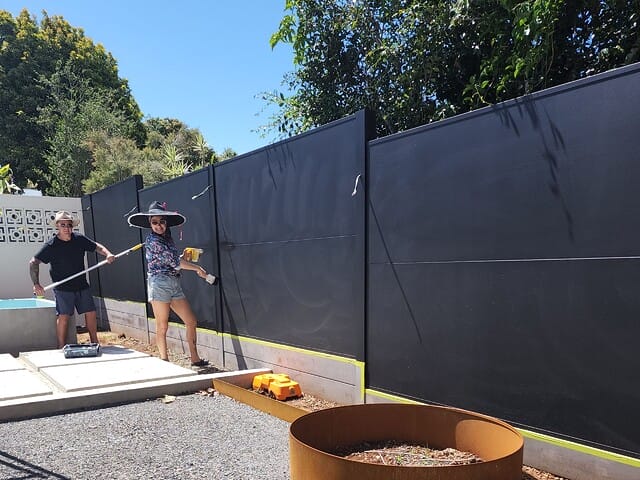Fencing disputes are tricky. For this reason, we’ve outlined all the potential issues, the relevant laws, and your rights and responsibilities when it comes to fencing.
What does this fencing disputes guide cover?
- Laws and legislation of dividing fences by state
- Mediation vs court
- Common fencing disputes and how to handle them
Neighbourly disputes are a common occurrence. From an easily resolved friendly disagreement to more serious disputes that require official intervention, neighbourly issues can arise over any number of things. Some of the most common disputes, however, are those to do with fencing.
Fencing is a tricky issue. Most houses share a dividing fence with at least one neighbour, and differences in opinion can be difficult to resolve. For this reason, power is knowledgeable; about all the potential issues, the relevant laws, and your rights and responsibilities when it comes to fencing.
What does the law say?
There are individual sets of laws and regulations in each Australian state when it comes to fencing. Here’s a summary of the fencing acts and laws in each state, as well as links to further information.
(Note: your local council may specify further rules and regulations regarding fencing. Check your local council website for more specific details pertaining to your area.)
Is taking it to court always worth it?
While any of the below disputes may eventually end up requiring legal intervention, sometimes it just isn’t worth letting things get to this stage.
Often, the costs involved with hiring solicitors and undergoing court proceedings will exceed the costs you may be trying to avoid paying in the first place. And even if you feel legal measures are worth it in a monetary sense, will they be worth the tension caused between you and your neighbours? You may get the ruling you want, but remember, you still have to live next door to them.
Taking fencing disputes to court should always be a last resort. Try any means necessary to resolve the issue privately or with a free mediation service — browse the Australian Mediation Association for more information about private mediation services.
Only when things get out of hand, or drag on for months without agreement, should legal action be considered.

Most common fencing disputes and how they can be resolved
I want to build a new fence but my neighbour doesn’t (or vice versa)
If there is currently no fence, or a fence that’s deemed inadequate, dividing two properties, a fence that suits the purposes of both parties must be built, with costs split equally. However, if the current fence is adequate according to government standards, but one neighbour wishes to build a new fence anyway, the other party is not legally required to pay an equal share in the construction.
In this case study examined in API Magazine, Neighbour 1 wished to build a relatively expensive fence along the properties’ boundary line to an existing wire fence. However, there was no legal requirement for anything other than the existing fence, and Neighbour 2 refused to pay half of the proposed amount. When an agreement could not be reached, the matter was headed for court, however Neighbour 1 had ‘little legal grounds to claim costs for the fence’.
Basically, if your desired new fence exceeds the legal requirements of a standard dividing fence, your neighbour has no obligation to contribute to its costs. Likewise, if your neighbour wishes to build a more expensive fence than you are willing to split the costs for, you’re in no way legally bound to pay half.
In these cases, it’s best to try to resolve the matter between yourselves without undergoing legal proceedings.
The location of a common boundary fence is disputed
In some cases, a boundary fence may have been built along the wrong demarcation between two properties. This may have come about from an illegal extension or moving of the fence, or it may be an existing issue that wasn’t picked up by a land surveyor. Another issue may arise if the building of a new fence is proposed and one neighbour does not agree with the proposed location.
Further investigation is required before any action is taken. If necessary, a survey of both blocks of land should be taken to determine the proper boundary line and see whether the existing or proposed dividing fence is in the right location.
This 2014 article from the Canberra Times warned that many homeowners could potentially have fences that overstep their property’s boundaries without even realising. It just goes to show that conducting proper surveying before purchasing a property can be vital!
Who pays for damaged fences?
We know that generally, all repair costs for dividing fences are shared equally between neighbours. But what if the damage was inflicted by one of the concerned parties? Or what if the damage was incurred naturally, but one party doesn’t believe in the need for repairs?
Generally, if one neighbour is responsible for the damage incurred on the dividing fence, it’s their responsibility to foot the entire repair bill.
- If the responsible neighbour doesn’t initiate repairs of their own accord, the other neighbour may discuss the issue and request repair.
- If an informal agreement is not reached, a fencing notice may be issued in accordance with the relevant state legislation.
- If this notice is still ignored, the matter may be taken further for mediation or court intervention.
If the damage has been incurred due to means outside either neighbour’s control, the responsibility and cost for repairs should be divided equally. If one neighbour doesn’t agree with the proposed repairs, or refuses to contribute, the other may proceed with the repairs after proper notice has been served; they can later seek to recover the owed contribution to the costs by legal means.
I think extra features are necessary, but my neighbour doesn’t
Additional features, such as acoustically rated fencing or integrated retaining, may be more important to one party than the other. For instance, the low side of a stepped boundary line will care more about the retaining wall, as they can see it, while the high side does not. These additional extras are usually discretionary; therefore, be prepared to cover those additional costs if you desperately want them included.
Good fences make good neighbours. Get in touch with our in-house team on 1300 556 957 for all the information to present to your neighbour.



